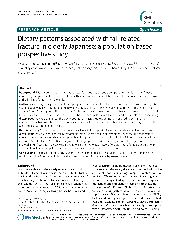摘要
Background: Diet is considered an important factor for bone health, but is composed of a wide variety of foods containing complex combinations of nutrients. Therefore we investigated the relationship between dietary patterns and fall-related fractures in the elderly.
Methods: We designed a population-based prospective survey of 1178 elderly people in Japan in 2002. Dietary intake was assessed with a 75-item food frequency questionnaire (FFQ), from which dietary patterns were created by factor analysis from 27 food groups. The frequency of fall-related fracture was investigated based on insurance claim records from 2002 until 2006. The relationship between the incidence of fall-related fracture and modifiable factors, including dietary patterns, were examined. The Cox proportional hazards regression model was used to examine the relationships between dietary patterns and incidence of fall-related fracture with adjustment for age, gender, Body Mass Index (BMI) and energy intake.
Results: Among 877 participants who agreed to a 4 year follow-up, 28 suffered from a fall-related fracture. Three dietary patterns were identified: mainly vegetable, mainly meat and mainly traditional Japanese. The moderately confirmed (see statistical methods) groups with a Meat pattern showed a reduced risk of fall-related fracture (Hazard ratio = 0.36, 95% CI = 0.13 - 0.94) after adjustment for age, gender, BMI and energy intake. The Vegetable pattern showed a significant risk increase (Hazard ratio = 2.67, 95% CI = 1.03 - 6.90) after adjustment for age, gender and BMI. The Traditional Japanese pattern had no relationship to the risk of fall-related fracture.
Conclusions: The results of this study have the potential to reduce fall-related fracture risk in elderly Japanese. The results should be interpreted in light of the overall low meat intake of the Japanese population.
- 出版日期2010
